Solubility Determination of c-Met Inhibitor in Solvent Mixtures and Mathematical Modeling to Develop Nanosuspension Formulation
Abstract
1. Introduction
2. Results and Discussion
2.1. Solid State Characterization
2.2. Equilibrium Solubility
2.2.1. Solubility in Organic Solvents
2.2.2. Solubility in Binary TWM Solvents
2.3. Ideal Solubilities and Activity Coefficients
2.4. Apparent Thermodynamic Analysis
2.5. Inhibitory Effects of Polymer on Drug Precipitation
2.6. Formation of Nanosuspension by Liquid Anti-Solvent Precipitation
3. Experimental Section
3.1. Materials
3.2. High Performance Liquid Chromatography
3.3. Solid State Characterization
3.4. Solubility in Different Organic Solvents
3.5. Ideal Solubilities and Activity Coefficients
3.6. Thermodynamic Models
3.6.1. Modified Apelblat Model
3.6.2. Van’t Hoff Model
3.6.3. Buchowski–Ksiazaczak λh Model
3.6.4. Yalkowsky Model
3.6.5. Jouyban–Acree Van’t Hoff Model
3.6.6. Data Correlation
3.7. Inhibitory Effect of Polymer on Drug Precipitation
3.8. Preparation of Nanosuspension
3.9. Dynamic Light Scattering
3.10. In Vitro Dissolution Study
3.11. Scanning Electron Microscope
4. Conclusions
Supplementary Materials
Author Contributions
Funding
Data Availability Statement
Acknowledgments
Conflicts of Interest
Sample Availability
References
- Kim, N.A.; Hong, S.; Kim, K.H.; Choi, D.H.; Kim, J.S.; Park, K.E.; Choi, J.Y.; Shin, Y.K.; Jeong, S.H. New Preclinical Development of a c-Met Inhibitor and Its Combined Anti-Tumor Effect in c-Met-Amplified NSCLC. Pharmaceutics 2020, 12, 121. [Google Scholar] [CrossRef] [PubMed]
- Yalkowsky, S.H.; Roseman, T.J. Techniques of solubilization of drugs. In Solubilization of Drugs by Cosolvents; Yalkowsky, S.H., Ed.; Marcel Dekker Inc.: New York, NY, USA, 1981; pp. 91–134. [Google Scholar]
- Shakeel, F.; Haq, N.; Alanazi, F.K.; Alsarra, I.A. Solubility and thermodynamics of apremilast in different mono solvents: Determination, correlation and molecular interactions. Int. J. Pharm. 2017, 523, 410–417. [Google Scholar] [CrossRef] [PubMed]
- Ahad, A.; Shakeel, F.; Alfaifi, O.A.; Raish, M.; Ahmad, A.; Al-Jenoobi, F.I.; Al-Mohizea, A.M. Solubility determination of raloxifene hydrochloride in ten pure solvents at various temperatures: Thermodynamics-based analysis and solute–solvent interactions. Int. J. Pharm. 2018, 544, 165–171. [Google Scholar] [CrossRef] [PubMed]
- Dadmand, S.; Kamari, F.; Acree, W.E.; Jouyban, A. Solubility prediction of drugs in binary solvent mixtures at various temperatures using a minimum number of experimental data points. AAPS PharmSciTech. 2019, 20, 10. [Google Scholar] [CrossRef] [PubMed]
- Ding, Z.; Zhang, H.; Han, D.; Zhu, P.; Yang, P.; Jin, S.; Li, M.; Gong, J. Solubility measurement and correlation of fosfomycin sodium in six organic solvents and different binary solvents at temperatures between 283.15 and 323.15 K. J. Chem. Eng. Data. 2017, 62, 3929–3937. [Google Scholar] [CrossRef]
- Du, C.; Xu, R.; Han, S.; Xu, J.; Meng, L.; Wang, J.; Zhao, H. Solubility determination and correlation for 1, 8-dinitronaphthalene in (acetone + methanol), (toluene + methanol) and (acetonitrile + methanol) mixed solvents. J. Chem. Thermodyn. 2016, 94, 24–30. [Google Scholar] [CrossRef]
- Wan, Y.; He, H.; Huang, Z.; Zhang, P.; Sha, J.; Li, T.; Ren, B. Solubility, thermodynamic modeling and Hansen solubility parameter of 5-norbornene-2, 3-dicarboximide in three binary solvents (methanol, ethanol, ethyl acetate+ DMF) from 278.15 K to 323.15 K. J. Mol. Liq. 2020, 300, 112097. [Google Scholar] [CrossRef]
- Shazly, G.; Haq, N.; Shakeel, F. Solution thermodynamics and solubilization behavior of diclofenac sodium in binary mixture of Transcutol-HP and water. Pharmazie 2014, 69, 335–339. [Google Scholar]
- Shakeel, F.; Alanazi, F.K.; Alsarra, I.A.; Haq, N. Solubilization Behavior of Paracetamol in Transcutol–Water Mixtures at (298.15 to 333.15) K. J. Chem. Eng. Data. 2013, 58, 3551–3556. [Google Scholar] [CrossRef]
- Alshehri, S.; Shakeel, F. Solubility determination, various solubility parameters and solution thermodynamics of sunitinib malate in some cosolvents, water and various (Transcutol + water) mixtures. J. Mol. Liq. 2020, 307, 112970. [Google Scholar] [CrossRef]
- Ha, E.-S.; Kuk, D.-H.; Kim, J.-S.; Kim, M.-S. Solubility of trans-resveratrol in Transcutol HP + water mixtures at different temperatures and its application to fabrication of nanosuspensions. J. Mol. Liq. 2019, 281, 344–351. [Google Scholar] [CrossRef]
- Alanazi, A.; Alshehri, S.; Altamimi, M.; Shakeel, F. Solubility determination and three dimensional Hansen solubility parameters of gefitinib in different organic solvents: Experimental and computational approaches. J. Mol. Liq. 2020, 299, 112211. [Google Scholar] [CrossRef]
- Apelblat, A.; Manzurola, E. Solubilities of o-acetylsalicylic, 4-aminosalicylic, 3, 5-dinitrosalicylic, and p-toluic acid, and magnesium-DL-aspartate in water from T=(278 to 348) K. J. Chem. Thermodyn. 1999, 31, 85–91. [Google Scholar] [CrossRef]
- Apelblat, A.; Manzurola, E. Solubilities of manganese, cadmium, mercury and lead acetates in water from T=278.15 K to T=340.15 K. J. Chem. Thermodyn. 2001, 33, 147–153. [Google Scholar] [CrossRef]
- Buchowski, H.; Ksiazczak, A.; Pietrzyk, S. Solvent activity along a saturation line and solubility of hydrogen-bonding solids. J. Phys. Chem. 1980, 84, 975–979. [Google Scholar] [CrossRef]
- Zhang, H.; Yin, Q.; Liu, Z.; Gong, J.; Bao, Y.; Zhang, M.; Hao, H.; Hou, B.; Xie, C. Measurement and correlation of solubility of dodecanedioic acid in different pure solvents from T=(288.15 to 323.15) K. J. Chem. Thermodyn. 2014, 68, 270–274. [Google Scholar] [CrossRef]
- Shao, X.; Ge, H.; Li, Z.; Ren, C.; Wang, J. Solubility of methylphosphonic acid in selected organic solvents. Fluid Phase Equilib. 2015, 390, 7–13. [Google Scholar] [CrossRef]
- Li, X.; Wang, M.; Du, C.; Cong, Y.; Zhao, H. Preferential solvation of rosmarinic acid in binary solvent mixtures of ethanol+water and methanol+water according to the inverse Kirkwood–Buff integrals method. J. Mol. Liq. 2017, 240, 56–64. [Google Scholar] [CrossRef]
- Vahdati, S.; Shayanfar, A.; Hanaee, J.; Martínez, F.; Acree, W.E., Jr.; Jouyban, A. Solubility of carvedilol in ethanol+propylene glycol mixtures at various temperatures. Ind. Eng. Chem. Res. 2013, 52, 16630–16636. [Google Scholar] [CrossRef]
- Shakeel, F.; Haq, N.; Salem-Bekhit, M.M. Thermodynamics of solubility of isatin in Carbitol+water mixed solvent systems at different temperatures. J. Mol. Liq. 2015, 207, 274–278. [Google Scholar] [CrossRef]
- Zhou, Z.; Qu, Y.; Wang, J.; Wang, S.; Liu, J.; Wu, M. Measurement and Correlation of Solubilities of (Z)-2-(2-Aminothiazol-4-yl)-2-methoxyiminoacetic Acid in Different Pure Solvents and Binary Mixtures of Water + (Ethanol, Methanol, or Glycol). J. Chem. Eng. Data. 2011, 56, 1622–1628. [Google Scholar] [CrossRef]
- Saadatfar, F.; Shayanfar, A.; Rahimpour, E.; Barzegar-Jalali, M.; Martinez, F.; Bolourtchian, M.; Jouyban, A. Measurement and correlation of clotrimazole solubility in ethanol+water mixtures at T=(293.2 to 313.2) K. J. Mol. Liq. 2018, 256, 527–532. [Google Scholar] [CrossRef]
- Sardari, F.; Jouyban, A. Solubility of nifedipine in ethanol+water and propylene glycol + water mixtures at 293.2 to 313.2 K. Ind. Eng. Chem. Res. 2013, 52, 14353–14358. [Google Scholar] [CrossRef]
- Asghar, S.Z.; Jouyban, A.; Martinez, F.; Rahimpour, E. Solubility of naproxen in ternary mixtures of {ethanol+propylene glycol+water} at various temperatures: Data correlation and thermodynamic analysis. J. Mol. Liq. 2018, 268, 517–522. [Google Scholar] [CrossRef]
- Holguín, A.R.; Rodríguez, G.A.; Cristancho, D.M.; Delgado, D.R.; Martínez, F. Solution thermodynamics of indomethacin in propylene glycol+water mixtures. Fluid Phase Equilib. 2012, 314, 134–139. [Google Scholar] [CrossRef]
- Lee, S.-K.; Sim, W.-Y.; Ha, E.-S.; Park, H.; Kim, J.-S.; Jeong, J.-S.; Kim, M.-S. Solubility of bisacodyl in fourteen mono solvents and N-methyl-2-pyrrolidone+ water mixed solvents at different temperatures, and its application for nanosuspension formation using liquid antisolvent precipitation. J. Mol. Liq. 2020, 113264. [Google Scholar] [CrossRef]
- Reid, G.L. Chapter 13-Residual solvents. In Specification of Drug Substances and Products, 2nd ed.; Riley, C.M., Rosanske, T.W., Reid, G., Eds.; Elsevier: Amsterdam, The Netherlands, 2020; pp. 345–365. [Google Scholar]
- Kuk, D.-H.; Ha, E.-S.; Ha, D.-H.; Sim, W.-Y.; Lee, S.-K.; Jeong, J.-S.; Kim, J.-S.; Baek, I.-h.; Park, H.; Choi, D.H. Development of a Resveratrol Nanosuspension Using the Antisolvent Precipitation Method without Solvent Removal, Based on a Quality by Design (QbD) Approach. Pharmaceutics 2019, 11, 688. [Google Scholar] [CrossRef]
- Zhang, J.; Xie, Z.; Zhang, N.; Zhong, J. Nanosuspension drug delivery system: Preparation, characterization, postproduction processing, dosage form, and application. In Nanostructures for Drug Delivery; Elsevier: Amsterdam, The Netherlands, 2017; pp. 413–443. [Google Scholar]
- Khan, S.; Matas, M.d.; Zhang, J.; Anwar, J. Nanocrystal preparation: Low-energy precipitation method revisited. Cryst. Growth Des. 2013, 13, 2766–2777. [Google Scholar] [CrossRef]
- Sullivan, D.W., Jr.; Gad, S.C.; Julien, M. A review of the nonclinical safety of Transcutol®, a highly purified form of diethylene glycol monoethyl ether (DEGEE) used as a pharmaceutical excipient. Food Chem. Toxicol. 2014, 72, 40–50. [Google Scholar] [CrossRef]
- Kim, K.H.; Oh, H.K.; Heo, B.; Kim, N.A.; Lim, D.G.; Jeong, S.H. Solubility evaluation and thermodynamic modeling of β-lapachone in water and ten organic solvents at different temperatures. Fluid Phase Equilib. 2018, 472, 1–8. [Google Scholar] [CrossRef]
- Ha, E.-S.; Lee, S.-K.; Choi, D.H.; Jeong, S.H.; Hwang, S.-J.; Kim, M.-S. Application of diethylene glycol monoethyl ether in solubilization of poorly water-soluble drugs. J. Pharm. Investig. 2020, 50, 231–250. [Google Scholar] [CrossRef]
- Shah, S.M.; Jain, A.S.; Kaushik, R.; Nagarsenker, M.S.; Nerurkar, M.J. Preclinical formulations: Insight, strategies, and practical considerations. J. AAPS Pharm. Sci. Tech. 2014, 15, 1307–1323. [Google Scholar] [CrossRef] [PubMed]
- Keck, C.M.; Müller, R.H. Drug nanocrystals of poorly soluble drugs produced by high pressure homogenisation. Eur. J. Pharm. Biopharm. 2006, 62, 3–16. [Google Scholar] [CrossRef] [PubMed]
- Jeong, S.-H.; Kim, K.-H.; Nam-Ah, K. Polymorphic forms of triazolopyrazine derivatives and method of preparing the same. US20190270747, 21 January 2020. [Google Scholar]
- Shakeel, F.; Haq, N.; Alanazi, F.K.; Alsarra, I.A. Measurement and correlation of solubility of olmesartan medoxomil in six green solvents at 295.15–330.15 K. Ind. Eng. Chem. Res. 2014, 53, 2846–2849. [Google Scholar] [CrossRef]
- Fedors, R.F. A method for estimating both the solubility parameters and molar volumes of liquids. J. Polym. Eng. 1974, 14, 147–154. [Google Scholar] [CrossRef]
- Marcus, Y. The properties of organic liquids that are relevant to their use as solvating solvents. Chem. Soc. Rev. 1993, 22, 409–416. [Google Scholar] [CrossRef]
- Jessop, P.G.; Jessop, D.A.; Fu, D.; Phan, L. Solvatochromic parameters for solvents of interest in green chemistry. Green Chem. 2012, 14, 1245–1259. [Google Scholar] [CrossRef]
- Anwer, M.K.; Mohammad, M.; Fatima, F.; Alshahrani, S.M.; Aldawsari, M.F.; Alalaiwe, A.; Al-Shdefat, R.; Shakeel, F. Solubility, solution thermodynamics and molecular interactions of osimertinib in some pharmaceutically useful solvents. J. Mol. Liq. 2019, 284, 53–58. [Google Scholar] [CrossRef]
- Schröder, B.; Santos, L.M.; Marrucho, I.M.; Coutinho, J.A. Prediction of aqueous solubilities of solid carboxylic acids with COSMO-RS. Fluid Phase Equilib. 2010, 289, 140–147. [Google Scholar] [CrossRef]
- Shakeel, F.; Alshehri, S.; Haq, N.; Elzayat, E.; Ibrahim, M.; Altamimi, M.A.; Mohsin, K.; Alanazi, F.K.; Alsarra, I.A. Solubility determination and thermodynamic data of apigenin in binary {Transcutol® + water} mixtures. Ind. Crop. Prod. 2018, 116, 56–63. [Google Scholar] [CrossRef]
- Chin, W.W.L.; Parmentier, J.; Widzinski, M.; Tan, E.H.; Gokhale, R. A brief literature and patent review of nanosuspensions to a final drug product. J. Pharm. Sci. 2014, 103, 2980–2999. [Google Scholar] [CrossRef] [PubMed]
- Raghavan, S.; Trividic, A.; Davis, A.; Hadgraft, J. Crystallization of hydrocortisone acetate: Influence of polymers. Int. J. Pharm. 2001, 212, 213–221. [Google Scholar] [CrossRef]
- Zimmermann, E.; Müller, R.H. Electrolyte-and pH-stabilities of aqueous solid lipid nanoparticle (SLN™) dispersions in artificial gastrointestinal media. Eur. J. Pharm. Biopharm. 2001, 52, 203–210. [Google Scholar] [CrossRef]
- Shakeel, F.; Imran, M.; Haq, N.; Alshehri, S.; Anwer, M. Synthesis, characterization and solubility determination of 6-Phenyl-pyridazin-3 (2H)-one in different pharmaceutical solvents. Molecules 2019, 24, 3404. [Google Scholar] [CrossRef]
- Connors, K.; Higuchi, T. Phase solubility techniques. Adv. Anal. Chem. Instrum. 1965, 4, 117–212. [Google Scholar]
- Kalam, M.A.; Alshehri, S.; Alshamsan, A.; Alkholief, M.; Ali, R.; Shakeel, F. Solubility measurement, Hansen solubility parameters and solution thermodynamics of gemfibrozil in different pharmaceutically used solvents. Drug Dev. Ind. Pharm. 2019, 45, 1258–1264. [Google Scholar] [CrossRef]
- Ruidiaz, M.A.; Delgado, D.R.; Martínez, F.; Marcus, Y. Solubility and preferential solvation of indomethacin in 1,4-dioxane+water solvent mixtures. Fluid Phase Equilib. 2010, 299, 259–265. [Google Scholar] [CrossRef]
- Hildebrand, J.H.; Prausnitz, J.M.; Scott, R.L. Regular and Related Solutions: The Solubility of Gases, Liquids, and Solids; Van Nostrand Reinhold Company: New York, NY, USA, 1970. [Google Scholar]
- Sieber, D.; Mühlenfeld, C.; El-Saleh, F. The Use of Cyclodextrins in Preparing an Oral Liquid Dosage Form of Itraconazole; Ashland Specialty Chemicals: Ashland City, Jackson County, OR, USA, 2018; pp. 1–4. [Google Scholar]
- Li, Y.; Wang, Y.; Yue, P.-F.; Hu, P.-Y.; Wu, Z.-F.; Yang, M.; Yuan, H.-L. A novel high-pressure precipitation tandem homogenization technology for drug nanocrystals production–a case study with ursodeoxycholic acid. Pharm. Dev. Technol. 2014, 19, 662–670. [Google Scholar] [CrossRef]
- Md, S.; Alhakamy, N.A.; Akhter, S.; Awan, Z.A.; Aldawsari, H.M.; Alharbi, W.S.; Haque, A.; Choudhury, H.; Sivakumar, P.M. Development of Polymer and Surfactant Based Naringenin Nanosuspension for Improvement of Stability, Antioxidant, and Antitumour Activity. J. Chem. 2020, 2020. [Google Scholar] [CrossRef]
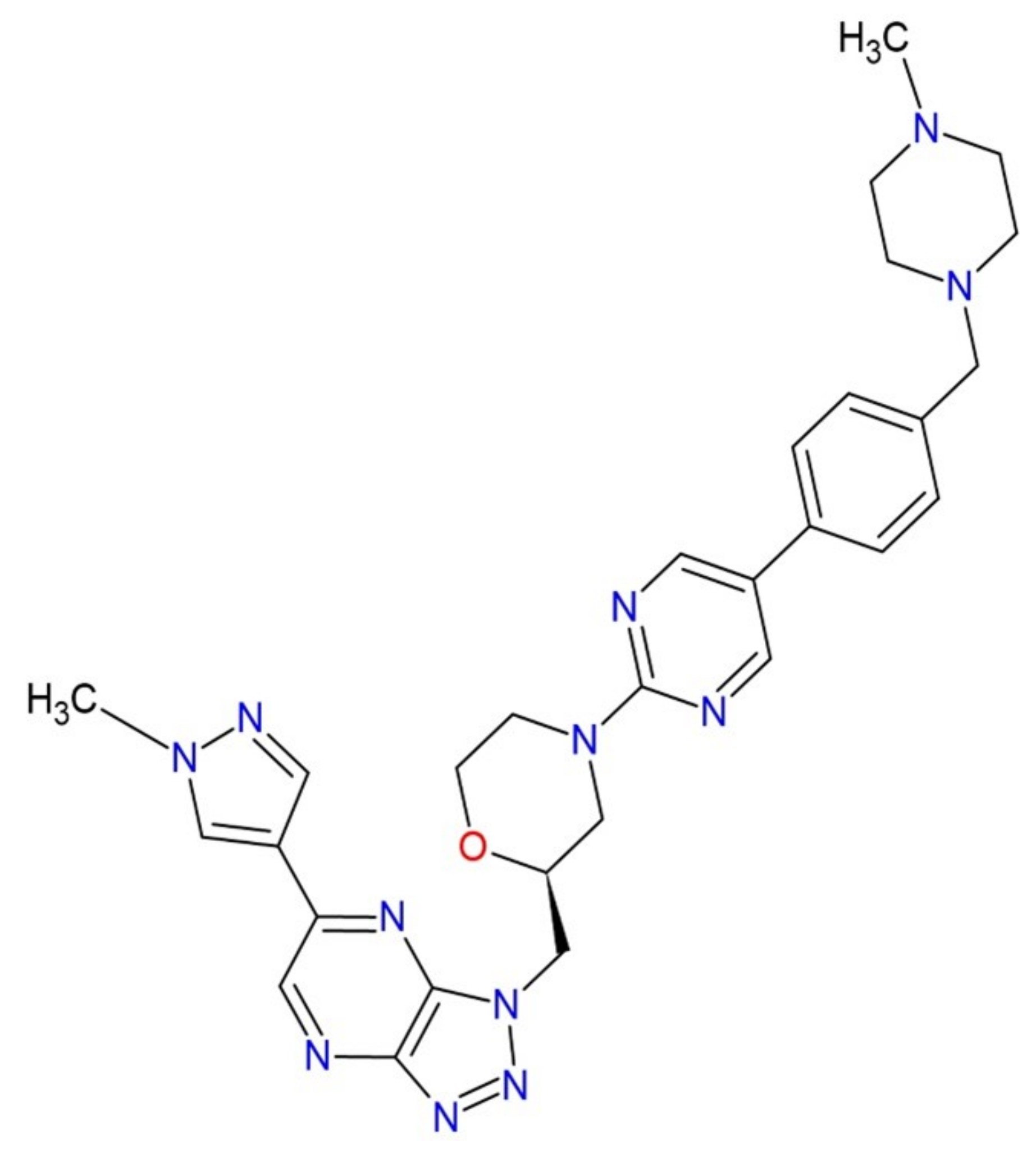
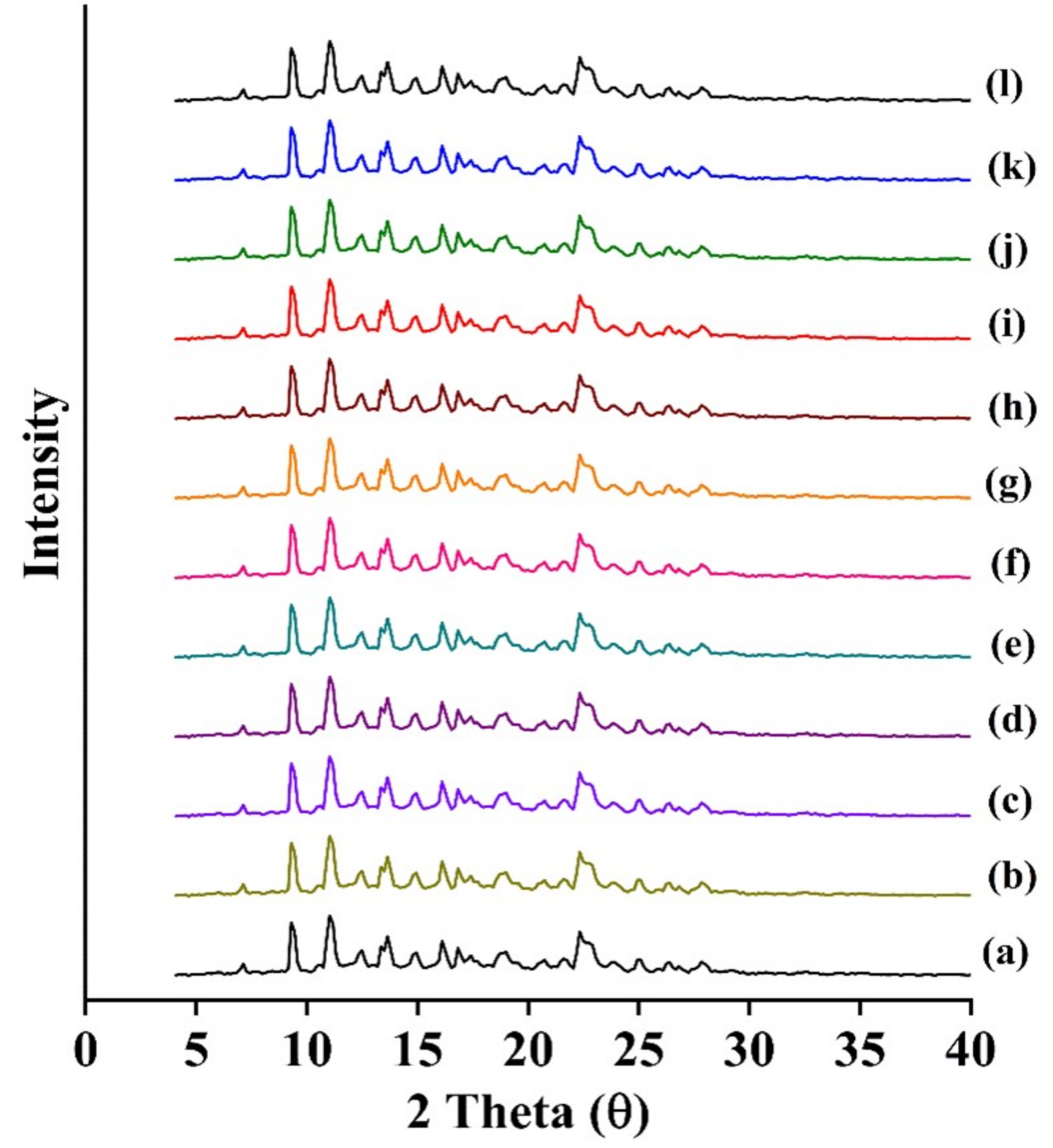
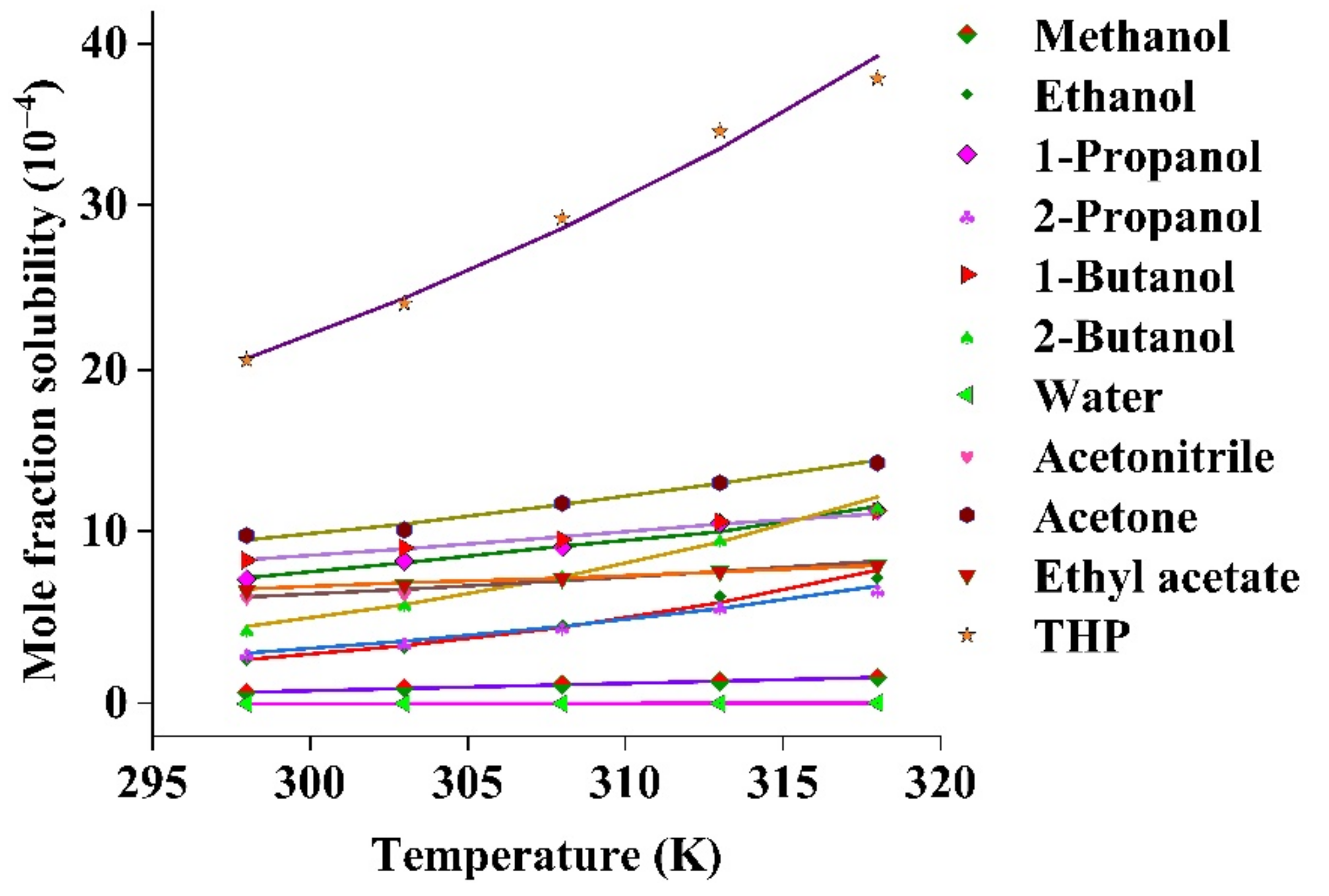
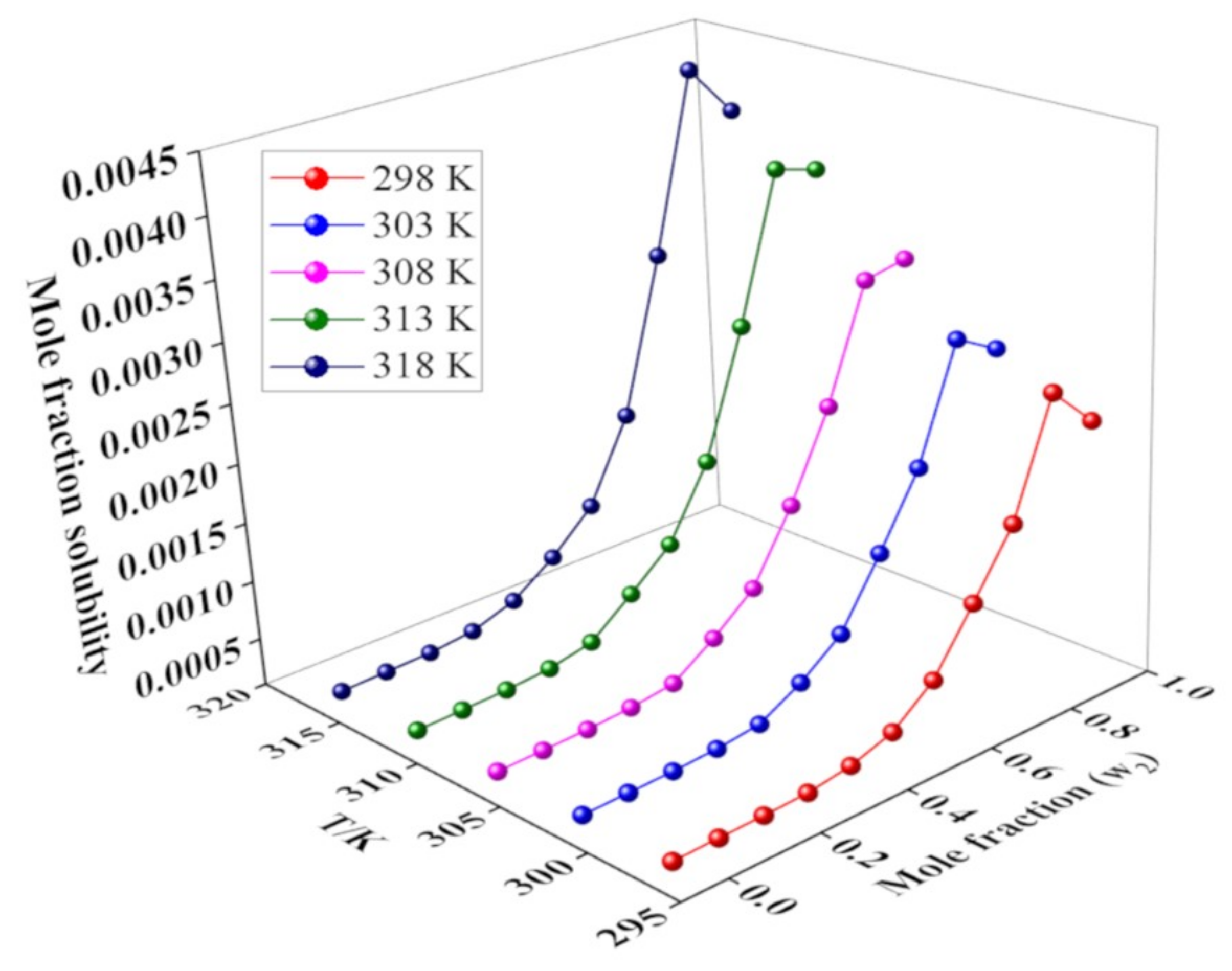

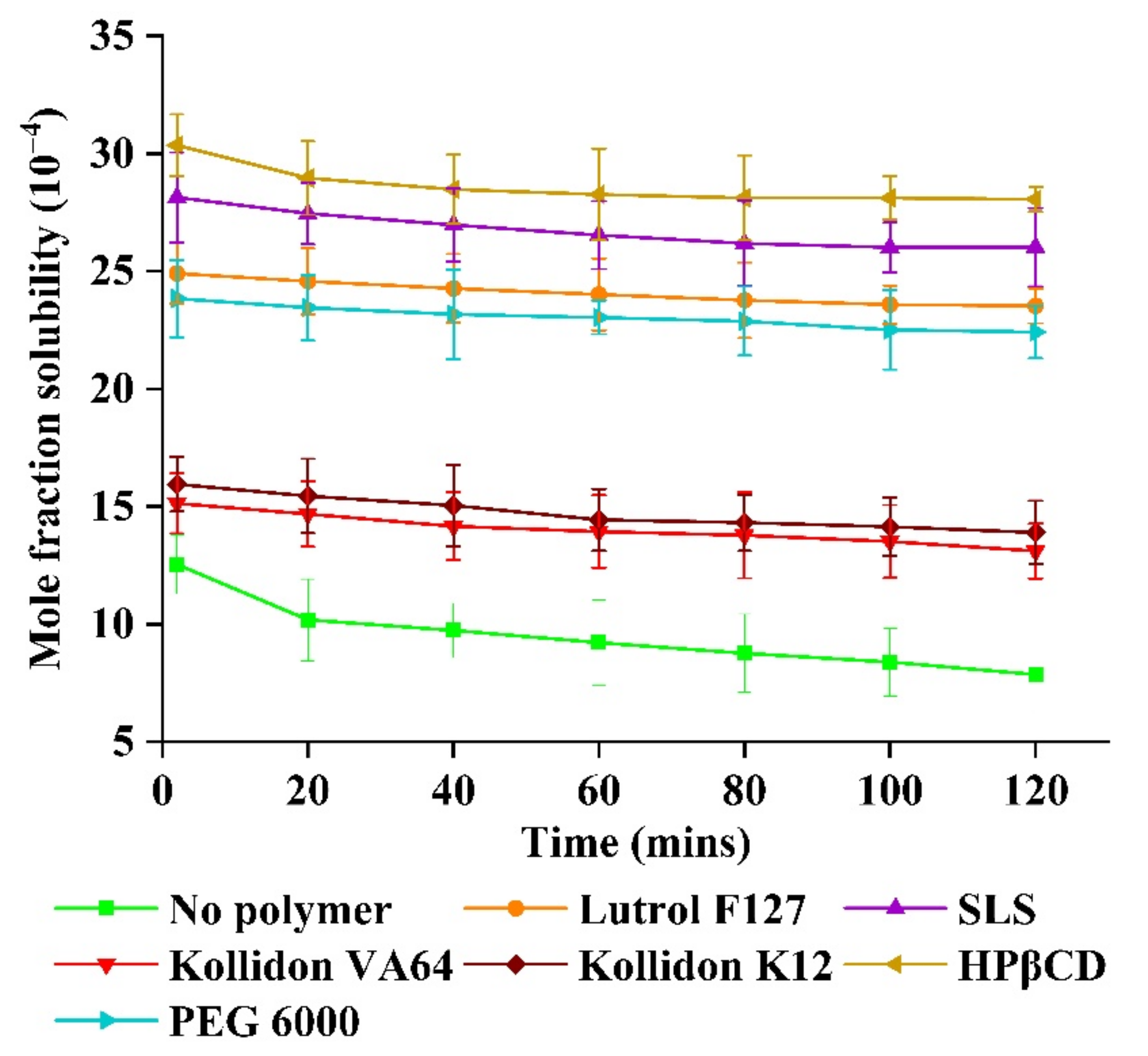
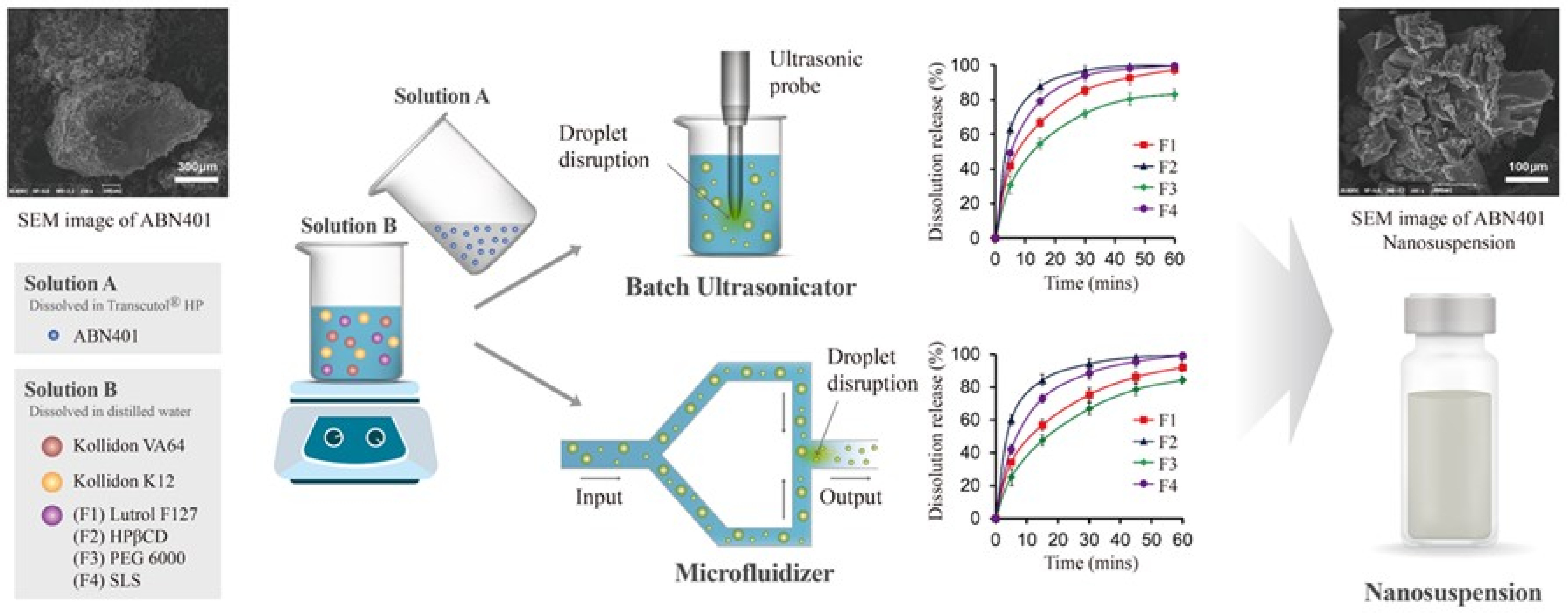
| Solvents | AM | VHM | BKM | |||||||
|---|---|---|---|---|---|---|---|---|---|---|
| A | B | C | RMSD*10−4 | a | b | RMSD*10−4 | λ *10−2 | h*10−3 | RMSD*10−4 | |
| Water | −374.54 | 14,006.70 | 55.25 | 0.001 | −2.72 | −2997.05 | 0.001 | 0.003 | 81,500 | 0.001 |
| Methanol | 490.45 | −26,827.80 | −72.07 | 0.032 | 5.46 | −4646.29 | 0.013 | 0.294 | 1552.96 | 0.014 |
| Ethanol | 787.98 | −41,435.30 | −115.39 | 0.189 | 11.44 | −5922.71 | 0.276 | 5.973 | 99.60 | 0.291 |
| 1-Propanol | 273.94 | −14,746.60 | −40.67 | 0.132 | 0.25 | −2229.99 | 0.163 | 0.298 | 581.15 | 0.187 |
| 2-Propanol | 205.50 | −13,595.70 | −29.52 | 0.086 | 6.88 | −4512.17 | 0.102 | 1.643 | 268.80 | 0.108 |
| 1-Butanol | −65.44 | 1399.93 | 9.42 | 0.224 | −2.07 | −1497.91 | 0.108 | 0.061 | 954.68 | 0.111 |
| 2-Butanol | 841.86 | −43,078.50 | −123.77 | 0.198 | 8.97 | −4988.55 | 0.250 | 4.456 | 110.99 | 0.270 |
| Acetonitrile | 120.15 | −7033.34 | −18.25 | 0.138 | −2.66 | −1417.25 | 0.140 | 0.040 | 1349 | 0.157 |
| Acetone | −318.55 | 12,641.10 | 47.25 | 0.230 | −0.58 | −1900.52 | 0.241 | 0.225 | 570.21 | 0.233 |
| Ethyl acetate | −31.99 | 264.30 | 4.17 | 0.029 | −3.93 | −1018.83 | 0.017 | 0.019 | 1936.12 | 0.026 |
| THP | 456.50 | −23,707.90 | −67.25 | 0.620 | 3.92 | −3010.37 | 0.777 | 2.587 | 106.47 | 0.859 |
| Overall | 0.171 | 0.190 | 0.205 | |||||||
| w2 | AM | VHM | BKM | ||||
|---|---|---|---|---|---|---|---|
| A | B | C | a | b | λ*10−3 | h*10−3 | |
| 0 | −374.974 | 14,025.4 | 55.2935 | −2.84474 | −2999.98 | 0.018 | 117,563 |
| 0.1 | −210.273 | 7229.53 | 30.6005 | −4.32968 | −2192.64 | 0.021 | 55,381.8 |
| 0.2 | 1291.7 | −62,115.9 | −192.138 | −1.40214 | −2954.84 | 0.135 | 17,284.6 |
| 0.3 | 845.029 | −42,649.8 | −125.119 | 2.97107 | −4124.51 | 0.702 | 4819.56 |
| 0.4 | −3387.62 | 150,906 | 503.981 | 4.20757 | −4273.88 | 2.208 | 1672.14 |
| 0.5 | 1816.02 | −86,808.6 | −269.254 | 3.92576 | −3902.93 | 4.872 | 693.367 |
| 0.6 | 339.704 | −17,966 | −50.5433 | −0.456256 | −2403.26 | 1.494 | 1003.25 |
| 0.7 | 57.707 | −4651.25 | −8.79499 | −1.483921 | −1943.19 | 1.193 | 706.422 |
| 0.8 | −615.06 | 25,244.2 | 91.7279 | −2.27488 | −3019.63 | 9.504 | 223.656 |
| 0.9 | −1264.99 | 55,224.9 | 188.166 | 1.38631 | −2713.24 | 10.772 | 169.065 |
| 1 | 456.071 | −23,804.5 | −67.4966 | 1.81408 | −3021.68 | 15.432 | 145.412 |
| MRD (%) | 4.869 | 5.032 | 5.804 | ||||
| JAVHM | |||||||
| Parameters | α1 | α2 | α3 | α4 | J1 | J2 | J3 |
| Value | −0.97 | −3128.83 | 4.12 | −2907.49 | 86.86 | −1664.92 | −1593.51 |
| MRD (%) | 7.08 | ||||||
| w2 | Ln x | ||||
|---|---|---|---|---|---|
| 298.15 K | 303.15 K | 308.15 K | 313.15 K | 318.15 K | |
| 0 | −12.78 | −12.61 | −12.46 | −12.34 | −12.12 |
| 0.1 | −12.12 | −11.95 | −11.80 | −11.67 | −11.47 |
| 0.2 | −11.46 | −11.29 | −11.14 | −11.00 | −10.81 |
| 0.3 | −10.80 | −10.63 | −10.47 | −10.33 | −10.16 |
| 0.4 | −10.14 | −9.98 | −9.81 | −9.67 | −9.50 |
| 0.5 | −9.48 | −9.32 | −9.15 | −9.00 | −8.85 |
| 0.6 | −8.82 | −8.66 | −8.48 | −8.33 | −8.19 |
| 0.7 | −8.16 | −8.00 | −7.82 | −7.66 | −7.54 |
| 0.8 | −7.50 | −7.34 | −7.16 | −7.00 | −6.88 |
| 0.9 | −6.84 | −6.69 | −6.50 | −6.33 | −6.23 |
| 1 | −6.19 | −6.03 | −5.83 | −5.66 | −5.58 |
| MRD (%) | 43.43 | 43.69 | 43.10 | 44.37 | 44.12 |
| Overall | 43.75 | ||||
| Solvents | γi | ||||
|---|---|---|---|---|---|
| T = 298.15 K | T = 303.15 K | T = 308.15 K | T = 313.15 K | T = 318.15 K | |
| Water | 887.91 | 609.19 | 431.99 | 314.50 | 211.50 |
| Methanol | 65.00 | 38.30 | 24.84 | 16.74 | 10.91 |
| Ethanol | 11.55 | 6.99 | 3.90 | 2.28 | 1.60 |
| 1-Propanol | 3.53 | 2.48 | 1.84 | 1.31 | 1.02 |
| 2-Propanol | 9.72 | 6.29 | 3.96 | 2.52 | 1.76 |
| 1-Butanol | 3.03 | 2.26 | 1.75 | 1.30 | 1.02 |
| 2-Butanol | 6.14 | 3.61 | 2.25 | 1.43 | 0.99 |
| Acetonitrile | 4.12 | 3.23 | 2.32 | 1.80 | 1.43 |
| Acetone | 2.56 | 2.01 | 1.42 | 1.06 | 0.81 |
| Ethyl acetate | 3.90 | 3.01 | 2.34 | 1.82 | 1.45 |
| THP | 1.22 | 0.85 | 0.57 | 0.40 | 0.30 |
| Formulations | Concentration (%, w/v) | Particle Size (nm) (Mean ± SD) | PDI (Mean ± SD) | Zeta Potential (mV) | |
|---|---|---|---|---|---|
| F1 | Kollidon® VA/Kollidon® K12/Lutrol® F127 | 1.0/0.5/1.0 | 54.9 ± 1.8 | 0.29 ± 0.03 | −35.2 ± 1.6 |
| F2 | Kollidon® VA/Kollidon® K12/HPβCD | 1.0/0.5/1.0 | 43.0 ± 0.6 | 0.27 ± 0.01 | −43.0 ± 2.3 |
| F3 | Kollidon® VA/Kollidon® K12/PEG 6000 | 1.0/0.5/1.0 | 53.1 ± 1.4 | 0.31 ± 0.02 | −34.5 ± 1.8 |
| F4 | Kollidon® VA/Kollidon® K12/SLS | 1.0/0.5/0.1 | 120.1 ± 2.2 | 0.33 ± 0.02 | −40.1 ± 2.1 |
Publisher’s Note: MDPI stays neutral with regard to jurisdictional claims in published maps and institutional affiliations. |
© 2021 by the authors. Licensee MDPI, Basel, Switzerland. This article is an open access article distributed under the terms and conditions of the Creative Commons Attribution (CC BY) license (http://creativecommons.org/licenses/by/4.0/).
Share and Cite
Ravi, M.; Julu, T.; Kim, N.A.; Park, K.E.; Jeong, S.H. Solubility Determination of c-Met Inhibitor in Solvent Mixtures and Mathematical Modeling to Develop Nanosuspension Formulation. Molecules 2021, 26, 390. https://doi.org/10.3390/molecules26020390
Ravi M, Julu T, Kim NA, Park KE, Jeong SH. Solubility Determination of c-Met Inhibitor in Solvent Mixtures and Mathematical Modeling to Develop Nanosuspension Formulation. Molecules. 2021; 26(2):390. https://doi.org/10.3390/molecules26020390
Chicago/Turabian StyleRavi, Maharjan, Tripathi Julu, Nam Ah Kim, Kyeung Eui Park, and Seong Hoon Jeong. 2021. "Solubility Determination of c-Met Inhibitor in Solvent Mixtures and Mathematical Modeling to Develop Nanosuspension Formulation" Molecules 26, no. 2: 390. https://doi.org/10.3390/molecules26020390
APA StyleRavi, M., Julu, T., Kim, N. A., Park, K. E., & Jeong, S. H. (2021). Solubility Determination of c-Met Inhibitor in Solvent Mixtures and Mathematical Modeling to Develop Nanosuspension Formulation. Molecules, 26(2), 390. https://doi.org/10.3390/molecules26020390







